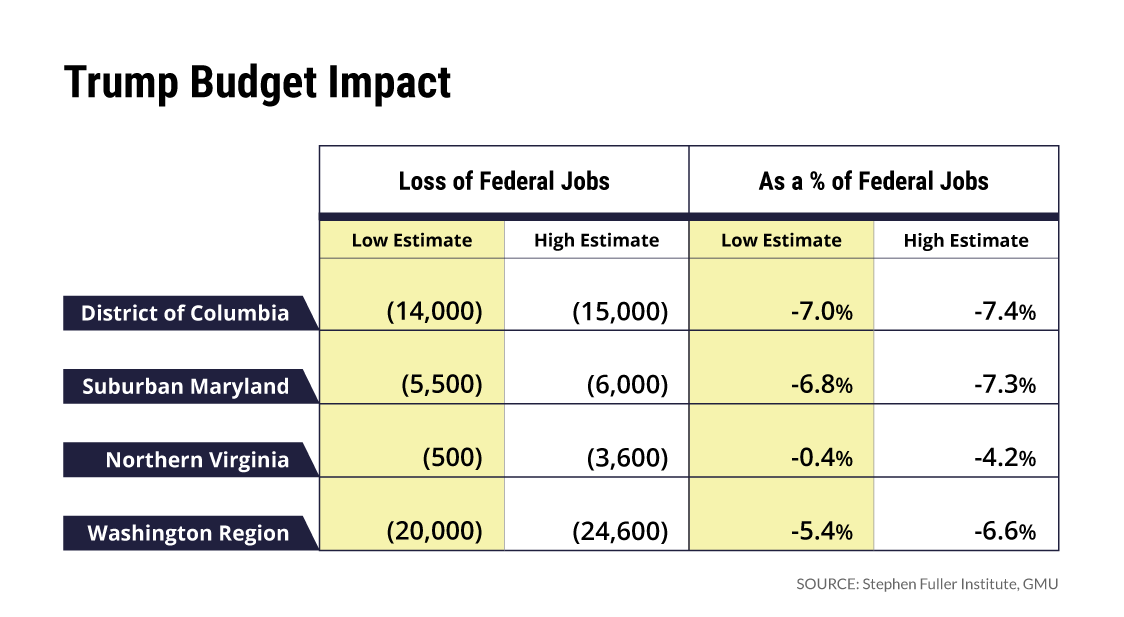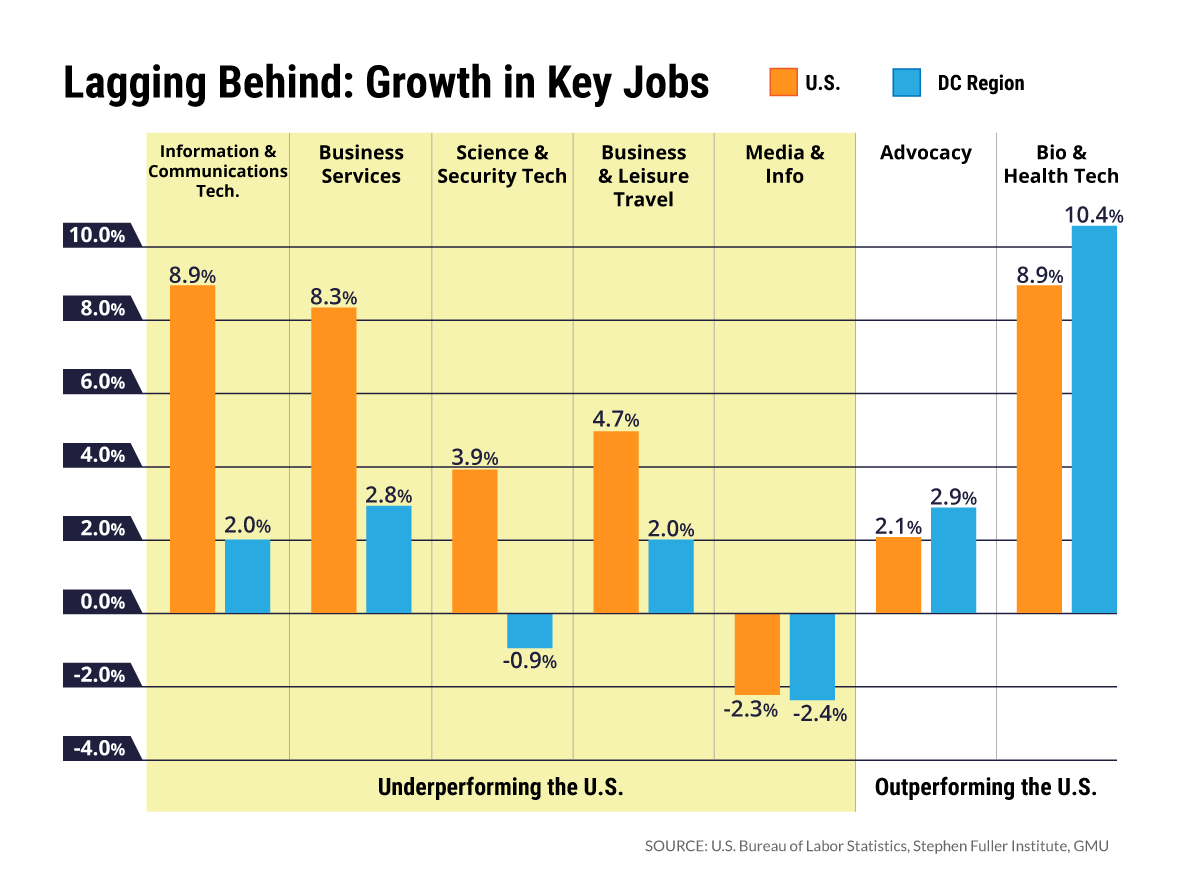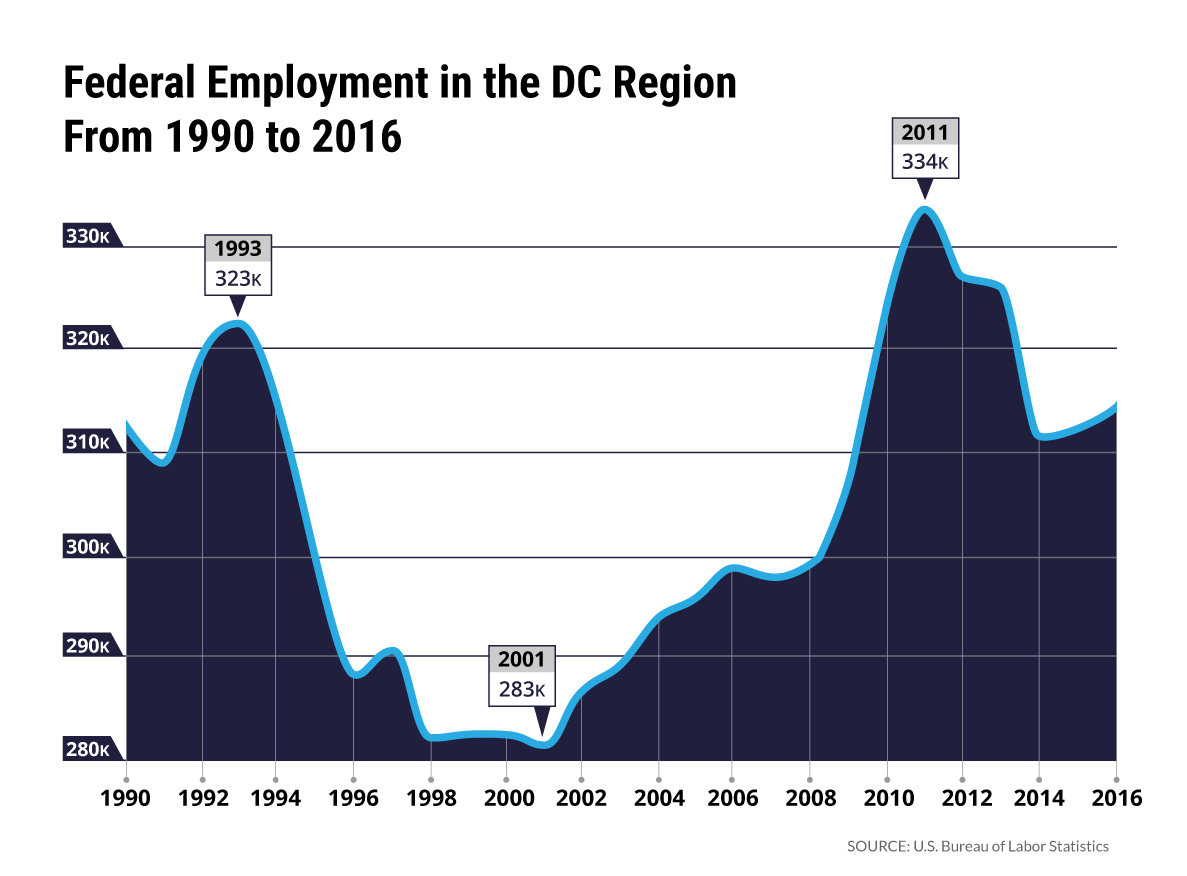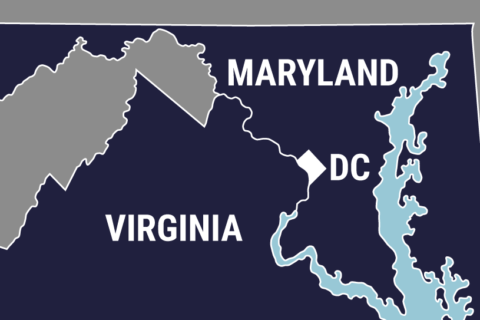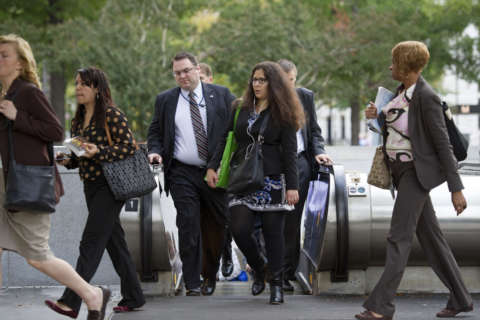WASHINGTON — For years, the skyline around D.C. has been dotted with cranes, the symbol of an economic boom in the nation’s capital and its once-sleepy suburbs.
Now, some economists and business leaders worry President Donald Trump’s budget blueprint — which proposes extreme cuts to federal programs — could be the wrecking ball.
Despite efforts to shed its “company town” image, the region has struggled to build industries not dependent on federal dollars and remains vulnerable to changes in government spending, experts say.
“We’re not prepared to absorb these kinds of shocks. And when you’re in a company town and your core business is increasingly uncertain … we should be worried about that,” said Stephen Fuller, an economist at George Mason University, who has studied the region’s economy for decades.
Beyond the federal cuts envisioned by the Trump administration, the D.C. area is caught in a tricky balancing act: Crafting an identity and economy outside the shadow of the federal government even as it remains dangerously dependent on Uncle Sam’s uncertain checkbook.
“We’ve been in an enviable position for decades. But enviable does not mean permanent as we’re learning now,” said Cary Hatch, CEO of MDB Communications, who’s spearheading a $5 million effort to rebrand the D.C. area as more than just monuments and government gridlock. “The regional economic picture is changing and not for the better.”
The impact of the Trump cuts
Congress, which returns to town this week, gets the final say on government spending — and even Republicans are expected to push back on some of the cuts.
Still, there’s widespread agreement that Trump’s proposed budget cuts would take a disproportionate bite out of the D.C. region’s economy.
A forecast of the proposed cuts compiled by Fuller predicts a loss of as many as 24,600 federal jobs in the D.C. region in 2018, alone, if the cuts are implemented. That translates to as much as $2.7 billion in lost payroll.
The proposed changes could have profound consequences for the local economy across sectors, since losing thousands of well-paid federal workers means fewer restaurant patrons, movie patrons, grocery shoppers and home buyers.
“All of these small businesses, the ones that look like they’re doing reasonably well right now are threatened,” Fuller said.
Trump’s proposed budget would also slash federal grants, which could cause the region, which boasts the largest nonprofit sector in the country, to lose out on as much as $1.1 billion, according to Fuller’s analysis.
“I do lose a lot of sleep right now as so many in the sector do, because of who we are and where we are,” said Rosie Allen-Herring, president and CEO of the United Way of the National Capital Area, during a panel discussion last month on the region’s economic future.
While Trump has proposed boosting spending at the Defense Department, Fuller said that likely means only modest gains in defense contracting — typically a cash cow for Northern Virginia.
“We aren’t going to get any of this DOD money, because they’re going to build ships and airplanes, and that isn’t what we do here,” Fuller said.
Creating new jobs: Can DC keep up with the pack?
Even putting aside the political foodfight over the federal budget, Fuller said he sees worrisome signs about the region’s efforts to grow good jobs that don’t rely on the government.
After the federal sequestration cuts roiled the local economy, local leaders and business execs got together to think long-term about the kind of jobs the D.C. area needed to grow in the future.
Planners focused on seven key areas, such as information technology, hospitality and business services. They were chosen for their existing employment levels, job quality, high wages, growth potential — and for being completely independent of federal dollars.
These were supposed to be the jobs that D.C., with its highly educated workforce, has a natural advantage in.
But over the past two years, new jobs in these areas grew by just under 2 percent, according to data Fuller presented at a meeting of local officials and business leaders late last month. That’s three times slower than the national average.
“Our share of them is lagging seriously. And so we have to understand: Why can’t we keep up with the pack,” Fuller said.
In fact, overall job growth in the region unexpectedly weakened last year despite initial projections indicating the strongest showing in new jobs since 2000. Last month, the Bureau of Labor Statistics released new figures that wiped out many of those job gains and ended up revising downward the entire pattern of growth for the region.
“This is like that poor frog put in the cold water on the stove, with the temperature rising … We’re in warm water at this point,” Fuller said.
Strengths, weaknesses and threats
Not everyone is ready to hit the panic button, arguing that uncertainty over federal spending forces the region to get serious about making changes.
“Maryland has always had great assets. But you wouldn’t know it, because we try to see if we can just live on government jobs,” Maryland Secretary of Commerce Mike Gill said at a business forum last month. He pointed to the 2015 review ordered by incoming Gov. Larry Hogan, which found the state underperforming its potential at creating jobs. In part, the report blamed dependence on the federal government’s coffers for holding back the state from fully competing in the “new economy.”
“From a standpoint of what the federal government may or may not do, I’m not going to lose any sleep,” Gill said when asked about Trump’s budget blueprint.
Local officials also point to the fact that D.C. has weathered lean times before, such as the 2008 recession and has seen its private sector economy rebound.
A 105-page economic strategy released last month by the D.C. government aims to continue growing the nongovernment economy by $20 billion over the next four years in part by expanding into cutting-edge tech fields, such as data science.
But the strategy also reveals the ambivalent relationship between the federal government and the D.C. region. The report lays out the region’s economic strengths, weaknesses and threats. At the top of each of those lists: the size and influence of the federal government.
“No region is going to be successful if they are focusing strictly on federal job growth,” Brian Kenner, deputy mayor for D.C. economic development, told WTOP. “I think that what we in Washington are trying to do is trying to get ahead of the curve in terms of diversifying our economy.”
The federal government will always be a part of the D.C. region’s economy. “But that is probably not our future,” he said.
In fact, the federal footprint in D.C. is already shrinking and has been for years.
“Go back to the Eisenhower era, [the federal government] was a full third of our workforce,” Chuck Bean, executive director of the Metropolitan Washington Council of Governments, said in an interview with WTOP. “In the ’90s, that shrunk to about 15 percent. And now, federal jobs are just 11 percent of the region’s workforce.”
Rebranding DC
The council of governments in a report issued earlier this year, called for more collaboration across the region to prepare workers for the jobs of the future.
“The region needs to define and embrace a positive identity, beyond that of being home to the federal government, as a region that fosters and supports a whole range of enterprises from data to biotech, hospitality to education, advocacy to policy,” the report urged.
In other words, less Uncle Sam and more software developer.
Embracing a new identity is also the theme of an ad campaign seeking to rebrand the D.C. region launched by a coalition of business groups called the 2030 Group.
“The rest of the country sees the greater Washington region through the eyes of the federal gridlock that exists and what gets reported on the news,” a solemn voiceover in the new ad intones as atmospheric shots of the D.C. skyline flash by. “But we are much more than a federal city.”
The new campaign, which aims to raise up to $5 million over the next 12-18 months, spotlights D.C.’s restaurant scene and comfortable climate for startups.
Planning for the ad campaign began several months ago, but the potential for political disruption has punctuated the urgency of the message, said Hatch, the communications professional who’s leading the rebranding effort.
“I worry that we may suffer from normalcy bias,” Hatch said during last month’s rollout before an audience of business leaders. “The notion that since greater Washington has been so fortunate for so very long, we are lulled into complacency and think that we will always see prosperity, just because it’s always been that way.”
WTOP’s Megan Cloherty contributed to this report. Graphics designed by Danny Yi.

